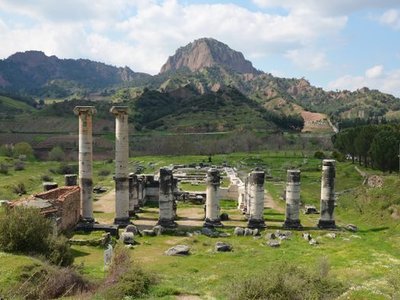Sardis


The ancient ruins of Sardis
are located in what is now the small town of Sart in
Turkey
. This archaeological site was once the grand capital of the kingdom of Lydia, which flourished in the Iron Age until it was conquered by Cyrus the Great of Persia in 546 BCE.
Two centuries later, Sardis surrendered to Alexander the Great, then fell into the hands of the Romans, and then was conquered by the Byzantine Empire. A rivalry with the Seljuk Turks followed, around which time the city’s decline began. By 1402, when the city was captured by the Turco-Mongol warlord Timur (better known as Tamerlane), it had been reduced to mere ruins until excavations and restorations began in the 19th century.
Lydia was one of the most industrially advanced countries in Asia Minor, and its capital served as a center of manufacture. It is believed that the concept of state-issued metal coinage was invented here during the reign of King Alyattes, circa 635-585 BCE.
Alyattes’s coins were small pieces of electrum—a naturally-occurring alloy of gold and silver—cut according to the local weight standards and stamped with an image of a lion’s head. Widely accepted in trade, history’s first counterfeits also appeared almost as soon as this new type of money was coined.
Furthermore, King Croesus, the son of Alyattes, is traditionally credited with the invention of gold and silver coins (known as “Croeseids”) after his metallurgists figured out a way to separate the two precious components of electrum. The concept of coinage soon spread throughout the ancient world.
Today, the archaeological ruins of Sardis are mostly found in two parts of Sart about twenty minutes apart. While the main site is known for its beautifully restored bath-gymnasium complex, largest synagogue from antiquity, and Byzantine shops where latrines not unlike
those of Ephesus
can be found, there is also a large Artemis temple complex not far away, white columns surrounded by the ancient mountains of Tmolus.